Gato Roboto is a lo-fi non-linear platformer about a cat who explores a dangerous research facility using a mobile security mech. The plot kicks off when a space navy lieutenant named Gary detects a signal from an installation that is believed to be abandoned. As he begins a landing sequence to investigate, Gary’s pet cat Kiki jumps onto the command console’s keyboard, sending the ship crashing into the installation’s roof. Gary is injured during the landing and trapped in the ship, leaving it up to Kiki to investigate the abandoned facility for the mysterious signal’s source while looking for a way to rescue Gary. The ensuing three hour adventure plunges the heroes into a mad scientist’s schemes.
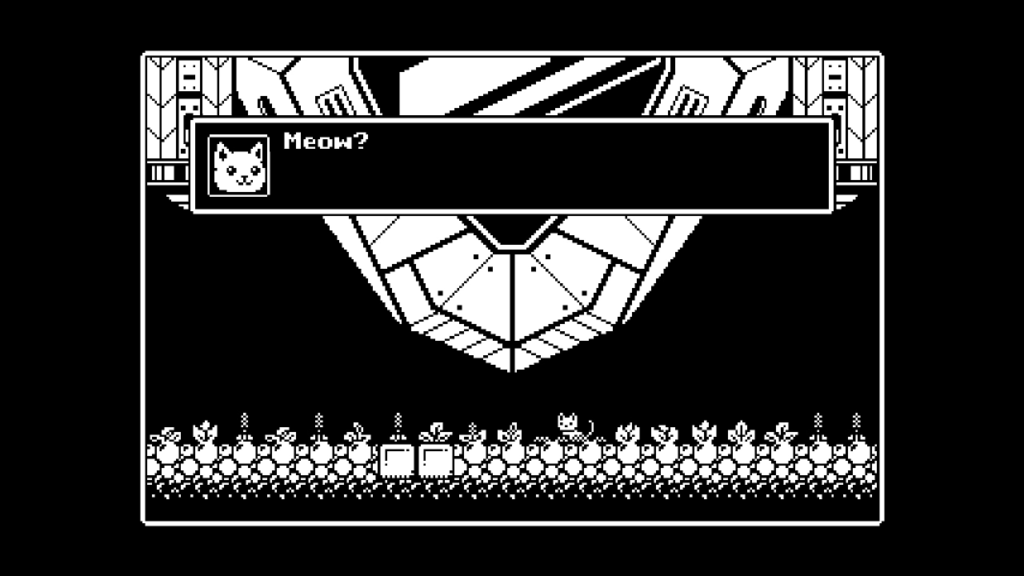
The main appeal of Gato Roboto is its premise: Kiki is an unremarkable house cat that successfully pilots mechanized armor to explore the facility and rescue Gary. Setting aside the aptitude a cat would need to drive a mech, the notion of a cat exploring a dangerous building at the direction of their human owner is too ridiculous to take seriously on its face. Anyone who has a relationship with a cat knows they don’t take direction, they merely tolerate our presence and use us to fulfill their needs. If my life depended on a cat, I know it would ignore my pleas. That Kiki is simultaneously a house cat and a proactive videogame protagonist encapsulates Gato Roboto’s lighthearted tone.
Every non-linear platformer owes its roots to Metroid to some extent, but Gato Roboto is especially fearless in showing this inspiration. The first environment Kiki explores is constructed from square tiles, textured to look like bubbly rocks with small plants sprouting from them. This look is instantly recognizable as drawn from Metroid’s early titles. The stark black-and-white graphics add to the similitude; if it weren’t for the cat in a mech jumping around the screen, I could mistake this for Samus’ monochromatic Game Boy outing. This faithful recreation of its classic inspiration’s visual style lends Gato Roboto a sense of authenticity. From the moment I assume control of Kiki, it is evident what kind of videogame I am about to play.
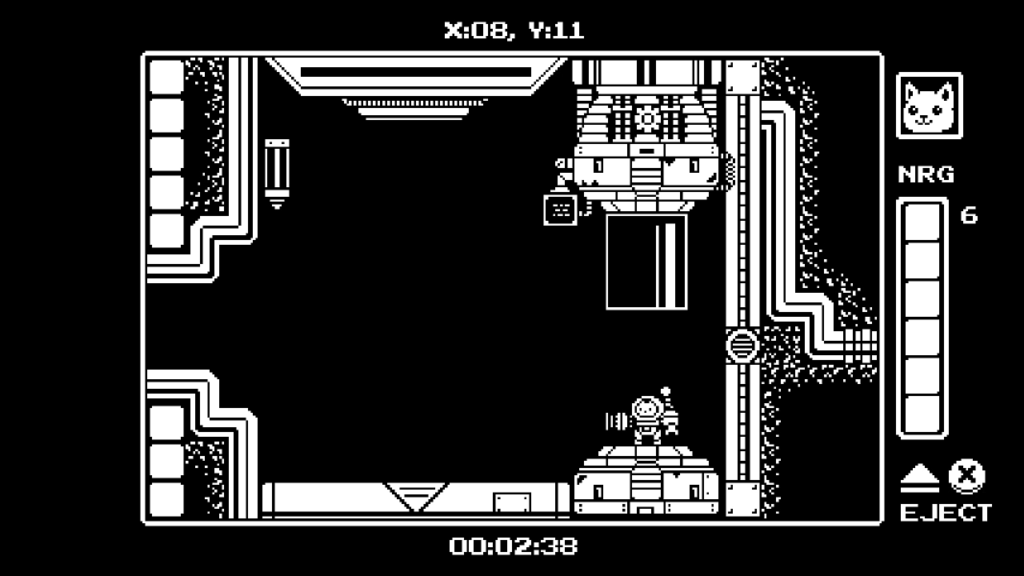
The first screen picks up immediately after Gary’s spacecraft crashes as Kiki leaps from the wreckage to the facility’s ground floor. Gary keeps in touch with her through her radio collar, sending regular mission updates to direct her to the next objective. Her first task is to find a station where she can enter a security mech, apparently a common addition to these kinds of facilities. I am able to move Kiki left and right from the crash site, soon discovering those non-linear platforming hallmarks of breakable barriers and just-out-of-reach platforms that require special tools to overcome. It doesn’t take long to find the first save point, not far from the crash site, which doubles as a spawning station for the mech Kiki uses to master the environment.
Once Kiki claims her mech, her ability to move around the facility improves dramatically. The mech isn’t anything flashy for a non-linear platforming player character to start out. Kiki can jump and fire an energy projectile from its arm cannon while piloting it from the inside. As she explores the facility, she finds upgrades that give it great mobility and firepower. I am surprised by none of the new utilities these additions provide.
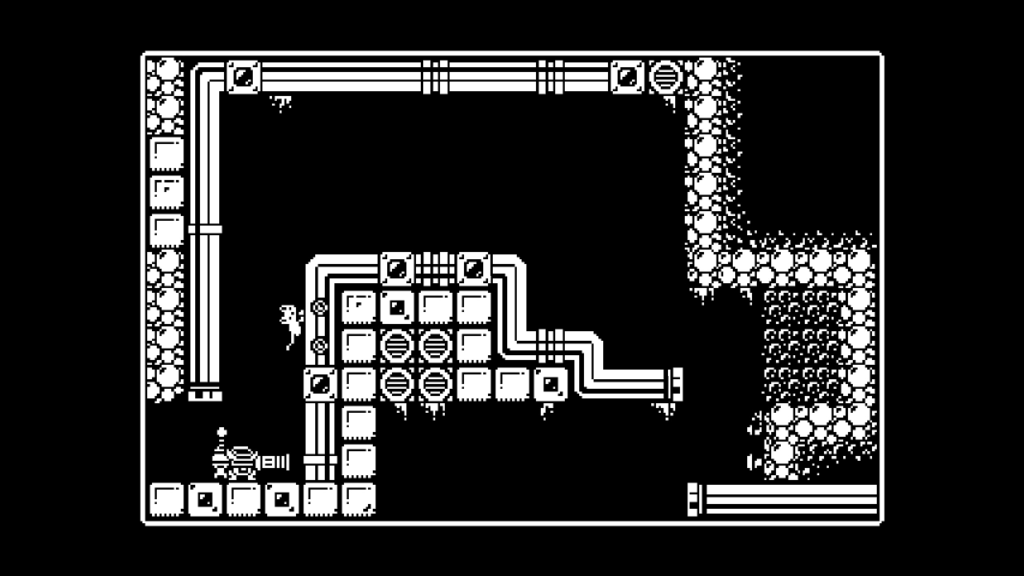
The more interesting wrinkle Gato Roboto adds to non-linear platforming is Kiki may leave the mech at any time. This gives her a few advantages, most importantly the ability to clamber up walls using her sharp claws. Her smaller frame lets her fit into passages the mech is too large to squeeze into. She can also swim through bodies of water which damage and repel the mech.
Several puzzles require Kiki to leave the mech sitting on movable platforms while she navigates a platforming challenge swarming with dangers, searching for the mechanism which safely delivers the mech across an otherwise-impassable obstacle. These occasional excursions are made more perilous by Kiki’s greatest disadvantage when outside the mech: She dies in a single hit from any enemy or obstacle that touches her.
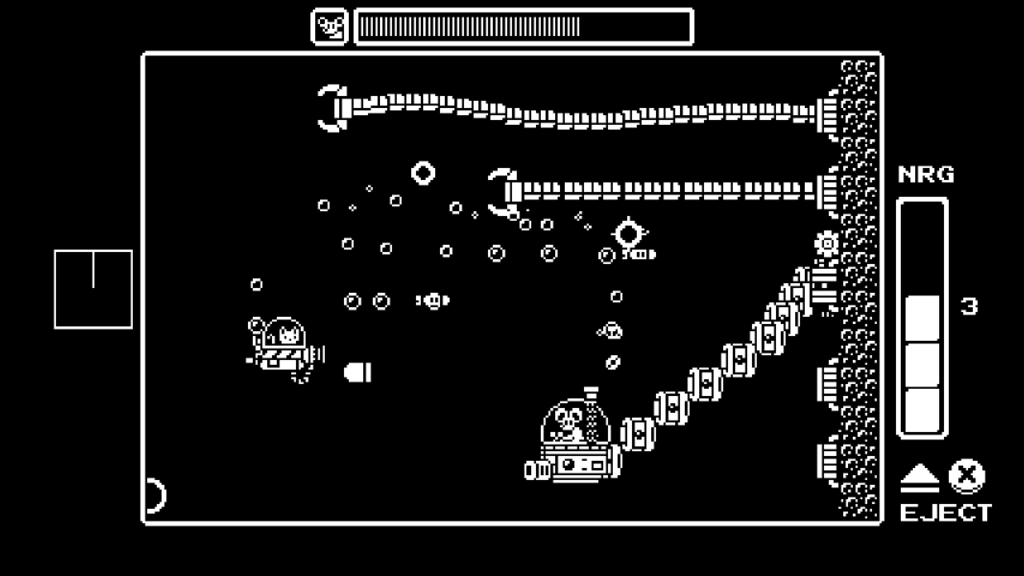
When it was still active, the research facility performed experiments on animals both alien and terrestrial, transforming them into powerful and hostile beasts that run wild through the rooms and hallways. Armadillos charge at Kiki on the ground, fish lunge at her in the water, and frogs snap at her in both. The alien fauna once again reach towards Metroid inspirations, including creatures that suspend themselves from the ceiling or lurk in pools of lava until Kiki comes close enough for them to leap out towards her. The most dangerous creatures are the mice, deceitful creatures with the knowledge to pilot the facility’s defenses against Kiki and her mech. These serve as the periodic boss fights.
Gato Roboto is short by non-linear platforming standards. This is due to the setting. The research facility is small. From the landing site, Kiki ventures into the Nexus, the hub that connects every section of the facility. The Laboratory broadcasting the signal is sealed by a malfunctioning computer, sending Kiki into three other sections of the facility to repair the systems preventing the lab doors from opening.
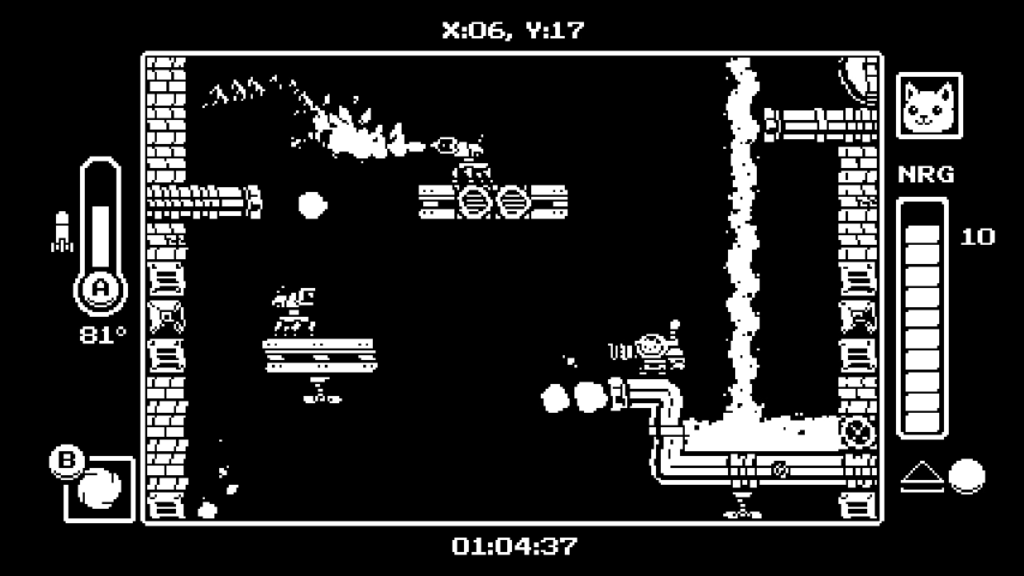
There’s a sense of defined balance between these three core areas as each emphasizes a different philosophy of Gato Roboto’s platforming design. The Aqueduct is flooded with water, forcing Kiki to spend as much time out of her mech suit as in it to stop the flooding. The Heater Core is pumped full of deadly heat; if Kiki takes one step out of her mech, she succumbs instantly, forcing her to navigate most of the area within the mech’s protective shell. The Ventilation area takes the opposite approach. The mech will not fit into the many ducts, demanding Kiki navigate the twisting tunnels without the protection of her suit. I appreciate this balance as it suggests thought was put into exploiting all the player character’s abilities through clearly defined and delineated level design.
Though I am free to take Kiki back and forth across any of these areas once they are open to her, I feel it would be incorrect to say we are “exploring” them. They do not contain enough substance to create the feeling that we are discovering things. There are a few passages and doorways which branch away from the main route, but they are brief and lead to nothing substantial. Returning to previous areas to claim the prerequisite non-linear platforming upgrades becomes a tedious exercise in retracing Kiki’s steps. It utterly fails to fill me with a sense of scale, wonder, or mystery.
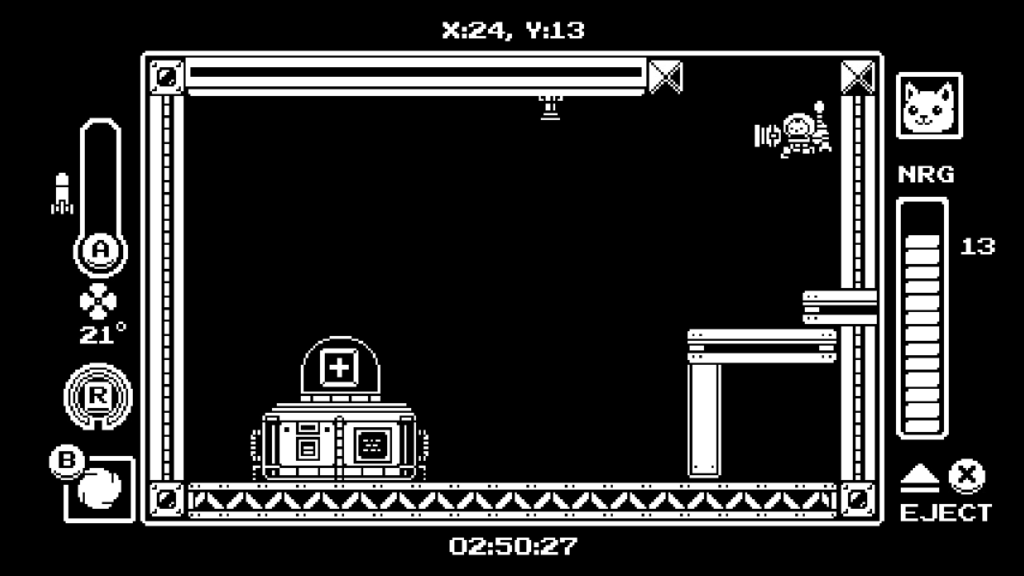
Despite my frustration with going back to claim them, the optional upgrades for Kiki’s mech are not useless. The most beneficial are the health upgrades, which grant an extra hit point to the mech—but not to Kiki. Collecting them all turns the mech from an efficient fighting machine to a tank with a nearly impenetrable hit point meter. That Kiki can only repair it at the facility’s save points becomes less and less of a problem as its hit point meter becomes thick with expendable wedges.
Less immediately useful are the cartridges. When Kiki picks one of these up, I am rewarded with a new color palette. New palettes let me tweak the simple screen colors beyond the stark black-and-white default, like the red-and-black Virtual Boy-inspired Virtual Cat, the grey-and-green Game Boy-inspired Swamp Match, or the black-and-green Meowtrix palette that brings to mind the primitive displays of the Apple IIe.
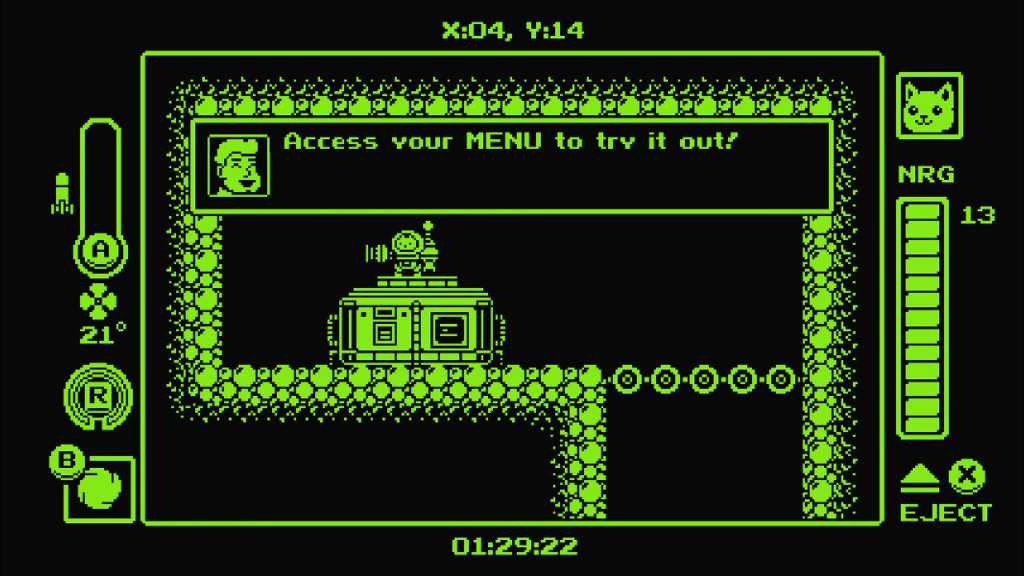
There are twenty-four upgrades hidden across the facility and only a few feel tricky to find. Most of their locations are obvious to me as soon as I pass them, it’s more a question of having the abilities required to reach them. Returning to claim these few adds barely a half-hour to my total playtime.
Gato Roboto coasts on a charming premise and competently familiar design. As a non-linear platformer, it provides no surprises. It’s well executed, but players familiar with other non-linear platformers—especially Metroid from which it culls liberally—may find little of their experience memorable. Its short length, consciously executed environment, and mild difficulty make it a pleasant way for genre fans to keep themselves busy, if not excited. This leaves its ridiculous premise of a house cat proactively and heroically exploring a dangerous space to save its owner to keep the player captivated. Gato Roboto is fun, I only wish it was more substantial and memorable.